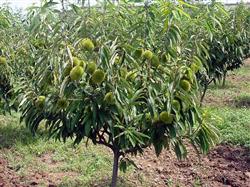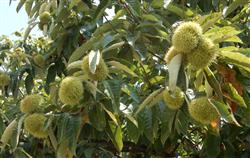Chestnut planting: how to trim chestnut trees in winter?

How to trim chestnut trees in winter? How to prune chestnut trees in winter? How do you trim it? Please introduce the method of planting chestnut trees, which need to be pruned in winter. The best pruning time for chestnut trees is from half a month after defoliation to half a month before spring germination. Detailed methods can be listed below: pruning of young chestnut trees: pruning of young chestnut trees, it is necessary to grasp the principle of "pruning during hibernation as a supplement, light rather than heavy, less thinning and not cutting". In winter pruning, cut off all the side branches below 50cm of the trunk, and remove the overdense branches, slender branches, overlapping branches and cross branches in the bore of the tree, at the same time, select the fruiting branch group, adjust the distance and direction between the branch groups, and cultivate the main branch. the extended branches of the backbone branches can be released slowly in one year and cut short in two years. The pruning of chestnut trees in the full fruit period: in this period, the disease and insect branches, dry and withered branches, whorled branches, cross branches, overlapping branches and slender branches should be cut off, so as to strengthen the ventilation and light transmittance in the crown and concentrate nutrients to make the fruiting branch group sturdy and full. For the elongated branches of apical branches and backbone branches, 50 cm short section should be left to promote lateral branches, the number of fruiting mother branches should be added, the fruiting area should be increased to increase yield, and the outward movement speed of crown should be controlled at the same time. Some of the overgrown branches in the bore or the middle and lower part of the big branches can be retained and transformed into fruiting mother branches, which not only increases the fruiting area, but also avoids the "empty chamber" in the canopy. For over-dense fruiting mother branches, some of them should be properly thinned, or a short part should be used as important new branches. Before the canopy meets, about 15 fruiting branches can be retained per square meter of crown projection area, and 13 fruiting branches can be retained after canopy joining, and the distance between branches is about 40 cm. The over-flourishing fruit-bearing branches can be properly worn to promote the lower part of the fruit-bearing branches to produce new shoots, and the senescent fruit-bearing branches should be retracted properly in order to promote the emergence of new branches and cultivate them into fruit-bearing branches. The pruning of aging chestnuts: for those serious old chestnuts, they can be dug to replenish their seedlings, and if there are sprouts at the base, they can be grafted into superior species, and then the aged trees can be sawed off after cultivation, and the space will be occupied by new or grafted seedlings without "empty chamber". For chestnut trees that do not show very serious senescence, the dry and withered branches and disease and insect branches can be cut off at this stage, the ungrown branches and thin and weak branches in the chamber can be truncated, and the senescent branches will be retracted to the strong branches, and the new branches will be produced in the coming year, from which the branches with good growth direction, well-developed and strong branches can be cultivated to make them become backbone branches and fruiting branches. The transformation of aging trees should not be carried out too quickly, but should be carried out in batches every year and adjusted step by step, so that its branches are evenly distributed, grow well and achieve the purpose of returning to normal results. Click to get more chestnut planting techniques click to get more fruit planting techniques
- Prev

Chestnut planting: why do chestnut trees need fertilizer before and after picking?
Why do chestnut trees need to be fertilized before and after picking? Can you tell me why? Fertilization before and after chestnut picking is because chestnut has a long fruit hanging period, a large amount of fruit, and consumes a lot of nutrients. Before and after fruit ripening, the tree potential has been in a state of hunger and semi-hunger, which is very weak, which is disadvantageous to blossom and bear fruit in the second year.
- Next

Chestnut planting: how to harvest chestnut?
How to harvest Chinese chestnut? When is the chestnut usually harvested? What are the main harvesting methods? Please introduce that Chinese chestnut generally matures from September to October. There are generally three harvesting methods for reference: chestnut harvest: chestnut bract method is called chestnut bract method. Hit the chestnut bud.
Related
- Moge, come on! The staff of the peasant association in the producing area of cantaloupe were frightened when the crowd gathered.
- Causes and Solutions of low Fruit setting rate of Apple
- Symptoms and control measures of passion fruit virus disease
- Fruit growing lesson: how do apple orchards keep high yields?
- Can you build orchards in the mountains? What are the pros and cons?
- How to manage the coloring period of Crisson grape?
- This paper introduces the processing technology of two kinds of fig products.
- How much is a month for retired teachers in rural areas by 2020?
- How can strawberry planting increase sugar content? We should pay attention to management in many aspects.
- What are the cultivation techniques on how to improve the yield of golden fruit?

